-
Countries
-
Data and Analysis
-
Special Focus
-
Crisis Responses

Contact
DTM Nigeria, AllUsersInDTMNigeria@iom.int
Language
English
Location
Nigeria
Period Covered
Jan 03 2022
Jan 31 2022
Activity
- Other
In the BAY states of North-east Nigeria (Borno, Adamawa and Yobe), various conflict escalations have been noted in recent times. The security situation remains unpredictable and leads to fluid mobility. Some violent attacks by NSAG (Non-State Armed Groups) were recorded in the last months of 2021 against IDPs, returnees and aid workers. At present, the humanitarian situation is rapidly approaching famine levels and is characterised by high levels of food insecurity, malnutrition and exposure to diseases.
Additionally, recent efforts by the Borno State Government (BSG) to shut down displacement camps in the urban centres of Borno State have created several risks and hardships. Many IDPs who resided in the camps have now integrated in camps and host communities in their LGAs of origin. In most cases, the security situation in areas of origin is still considered unsafe and does not allow for a safe return to their villages. The influx of IDPs in the respective LGAs has resulted in additional pressure on already stretched facilities and services across the camps and host communities.
In order to find durable solutions for internal displacement — whether through return to communities of origin, local integration, or relocation — and to prevent new displacements in the region, it is critical to understand the relative levels of stability in locations hosting returnees or displaced populations. Therefore, IOM has launched the Stability Index (SI) in Nigeria, to evaluate the stability of areas hosting returnees or displaced populations. The SI seeks to understand which factors influence a location's stability, which can inform priority programmatic interventions along the humanitarian, peace and development nexus in order to strengthen the resilience and stability and prevent future forced displacements.
This report presents the result from the second Stability Index round conducted in January 2022 in Nigeria’s BAY states (Borno, Adamawa and Yobe).

Contact
DTM Nigeria, AllUsersInDTMNigeria@iom.int
Language
English
Location
Nigeria
Period Covered
Apr 11 2022
Apr 17 2022
Activity
- Event Tracking
- Mobility Tracking
The DTM Emergency Tracking Tool (ETT) is deployed to track and to collect information on large and sudden population movements, provide frequent updates on the scale of displacement and quantify the affected population when needed. As a sub-component of the Mobility Tracking methodology in Nigeria. ETT utilises direct observation and a broad network of key informants to capture best estimates of the affected population per location, enabling targeted humanitarian response planning.
Between 11 and 17 April 2022, a total of 2,081 movements were recorded in Adamawa and Borno States. The recorded movements consisted of 1,632 arrivals and 449 departures. Arrivals were recorded at locations in Askira/Uba, Bama, Gwoza, Kala/Balge, Monguno and Ngala Local Government Areas (LGAs) of the most conflict-affected state of Borno and in Fufore, Gombi, Hong, Lamurde, Maiha, Michika, Mubi North, Mubi South, Song, Yola North and Yola South LGAs of Adamawa State.
Departures were recorded in Askira/Uba and Bama LGAs of Borno State and in Fufore, Gombi, Hong, Lamurde, Michika, Mubi North, Numan and Song LGAs of Adamawa State. ETT assessments identified the following movement triggers: voluntary relocation (1,033 individuals or 49%), poor living conditions (391 individuals or 19%), military operations (332 individuals or 16%), improved security (205 individuals or 10%) and seasonal farming (120 individuals or 6%).
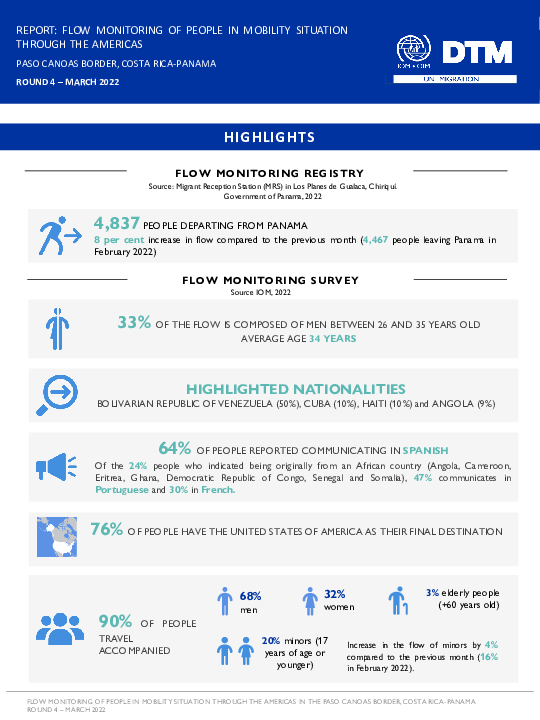
Contact
Angelica Madrigal amadrigal@iom.int / Miranda Mora mmora@iom.int
Language
English
Location
Costa Rica
Period Covered
Mar 01 2022
Mar 31 2022
Activity
- Flow Monitoring
In the framework of the COVID-19 emergency, since March 19, 2020, the Government of Costa Rica has kept its land border with Panama closed for the Controlled Flow Binational Operation, which sought an orderly and safe migration of migrants moving through the Americas.
Between August 2021 and January 2022, 93,139 migrants entered Panama: Haiti (61%), Cuba (11%), Chile and Brazil with 7 percent, Bolivarian Republic of Venezuela (4%), among other countries in South America, Africa, and Asia (10%).
In Costa Rica, during 2022, a steady increase in the number of migrants of this migration flow has been identified (it had increased by 26 percent compared to December 2021, when the flow monitoring in Costa Rica began). In addition, according to data from the General Directorate of Migration and Foreigners (DGME), between May 2021 and February 2022, 5,331 rejections were made in Paso Canoas.
In Costa Rica, there are many perceived vulnerabilities: people traveling alone, children, disoriented elderly people, people with medical problems, emotional exhaustion caused by stress, anguish, and frustration. In addition, the principal needs detected are associated with access to food, clothing, diapers, shelter, medicines, and transportation. Many people have lost their identification documents and are reluctant to receive medical assistance as they believe that they will not be allowed to continue their journey.
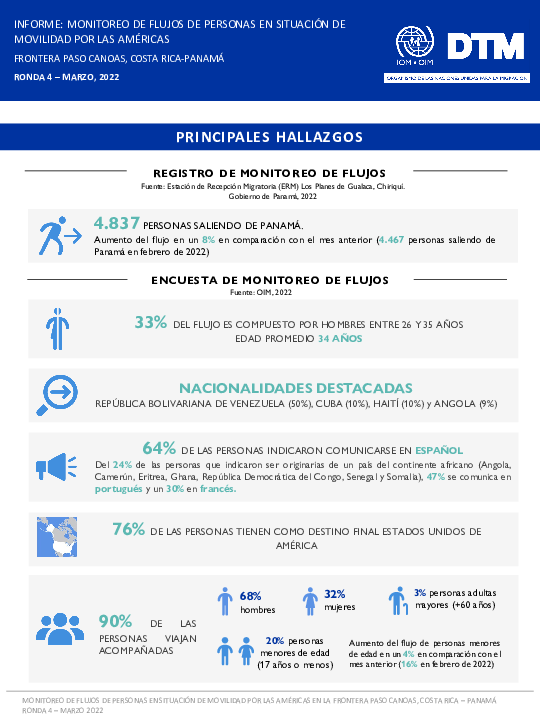
Contact
Angelica Madrigal amadrigal@iom.int / Miranda Mora mmora@iom.int
Language
Spanish
Location
Costa Rica
Period Covered
Mar 01 2022
Mar 31 2022
Activity
- Flow Monitoring
En el marco de la emergencia por la COVID-19, desde el 19 de marzo del 2020, el Gobierno de Costa Rica mantiene cerrada su frontera terrestre con Panamá para la Operación Binacional Flujo Controlado, la cual procuraba una migración ordenada y segura de personas migrantes en situación de movilidad por América3.
Desde agosto de 2021 y enero de 2022, han ingresado a Panamá 93.139 personas migrantes: Haití (61%), Cuba (11%), Chile y Brasil con 7%, República Bolivariana de Venezuela (4%), entre otros países del Sur de América, África y Asia (10%).
En Costa Rica, durante el 2022, se ha identificado un aumento constante en la cantidad de personas migrantes de este flujo migratorio (ha aumentado en un 26% en comparación con diciembre, 2021, cuando inició el monitoreo de flujos en Costa Rica). Además, de acuerdo con datos de la Dirección General de Migración y Extranjería (DGME), durante mayo de 2021 y febrero de 2022 se han realizaron 5.331 rechazos5 en Paso Canoas.
En Costa Rica se perciben muchas vulnerabilidades: personas viajando solas, niños y niñas, personas adultas mayores desorientadas, personas con problemas médicos, desgaste emocional ocasionado por estrés, angustia y frustración. Además, las principales necesidades detectadas se asocian con el acceso a alimento, ropa, pañales, alojamiento, medicamentos y transporte. Muchas personas han perdido sus documentos de identificación y se reúsan a recibir asistencia médica, pues consideran que no se les permitiría continuar con su viaje.

Contact
DTMAfghanistan@iom.int
Language
English
Location
Afghanistan
Period Covered
Dec 04 2021
Jan 01 2022
Activity
- Other
This report provides a snapshot of the third round of RLS data collection, as well as a comparison of data that was collected among those returnees who also participated in the second round (September-October 2021). Round 3 of RLS data collection took place between 4 December 2021 and 1 January 2022 with Afghan migrants who returned from Turkey or the EU between January 2018 and July 2021. 666 returnees (577 from Turkey and 89 from the EU) were interviewed in-person and over the phone across 92 districts in 15 provinces.

Contact
DTMUkraine@iom.int
Language
English
Location
Ukraine
Period Covered
Apr 11 2022
Apr 17 2022
Activity
- Survey
Starting on 24 February 2022 the war in Ukraine triggered an unprecedented humanitarian crisis across all of the country’s sub regional divisions (oblasts). Between 11 April and 17 April the International Organization for Migration (IOM) conducted the third round of a rapid representative assessment of the general population in Ukraine to gather insights into internal displacement and mobility flows, and to assess local needs. This general population survey serves as a preliminary source to identify areas with high humanitarian needs and to inform the targeting of response aiming to assist the war affected population. The geographical scope of the assessment covers the entire territory of Ukraine, all five macro regions ( East, North, Centre, South, and the city of Kyiv), with the exception of the Crimean peninsula. The general population survey was constructed through a random-digit-dial (RDD) approach, and 2,000 unique and anonymous respondents aged 18 and over were interviewed using the computer-assisted telephone interview (CATI) method. The estimates rely on the UNFPA population data for Ukraine, agreed upon as the common population baseline by the humanitarian community. Those currently outside Ukraine were not interviewed. For further notes on method and limitations, including IOM’s definition of internally displaced persons used for the purpose of this assessment, see page 11.
This report is also available in Ukrainian.
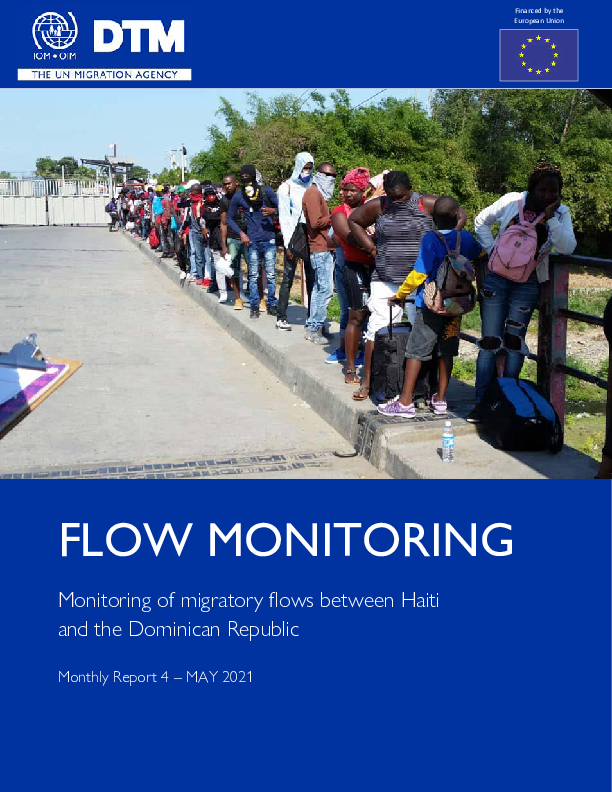
Contact
DTM Haiti, DTMHaiti@iom.int
Language
English
Location
Haiti
Period Covered
May 01 2021
May 31 2021
Activity
- Flow Monitoring
The migration flow between Haiti and the Dominican Republic (DR) in the island of Hispaniola is highly active and challenging as it is estimated that over half a million foreign born persons are living as irregular migrants in the DR, the vast majority of which - (497,825 persons)1 - being from the neighboring Republic of Haiti. Consequently, migration management between Haiti and the Dominican Republic and the protection of vulnerable migrants remains a major challenge on the island.
Due to the significant influx of returnees and in support of the Government of Haiti, IOM Haiti has established a Displacement Tracking Matrix initiative which focuses on reinforcing monitoring and data collection of border movement between the two countries. Border & Flow Monitoring aims to provide information on cross border returns of migrants from the Dominican Republic into Haiti and support the systematic identification, registration and profiling of Haitian migrants returning and/or being deported at all border crossing points with the DR in to provide key information on risks, needs and migration patterns. The previous application of the Border and Flow Monitoring monitored migratory flows on 50 Border Crossing Points – 4 official and 46 unofficial. The current one covers 20 Border Crossing Points – 4 official and 16 unofficial in collaboration with the Support Group for the Repatriated and Refugees (GARR2 in French).
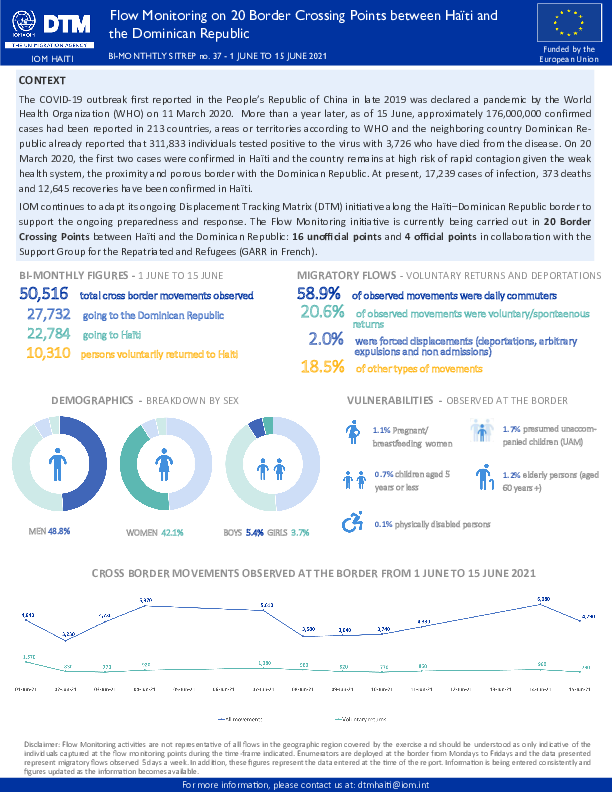
Contact
dtmhaiti@iom.int
Language
English
Location
Haiti
Period Covered
Jun 01 2021
Jun 15 2021
Activity
- Flow Monitoring
The COVID-19 outbreak first reported in the People’s Republic of China in late 2019 was declared a pandemic by the World Health Organization (WHO) on 11 March 2020. More than a year later, as of 15 June, approximately 176,000,000 confirmed cases had been reported in 213 countries, areas or territories according to WHO and the neighboring country Dominican Re public already reported that 311,833 individuals tested positive to the virus with 3,726 who have died from the disease. On 20 March 2020, the first two cases were confirmed in Haïti and the country remains at high risk of rapid contagion given the weak health system, the proximity and porous border with the Dominican Republic. At present, 17,239 cases of infection, 373 deaths and 12,645 recoveries have been confirmed in Haïti.
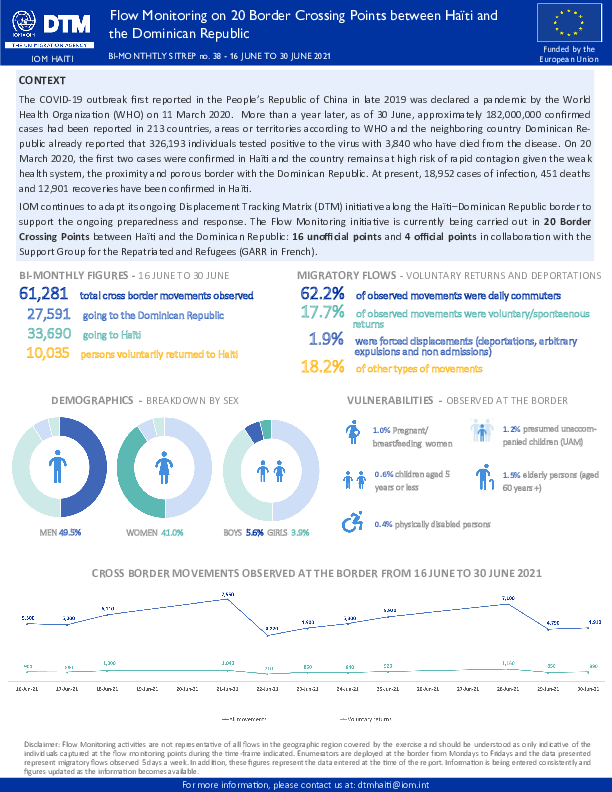
Contact
dtmhaiti@iom.int
Language
English
Location
Haiti
Period Covered
Jun 16 2021
Jun 30 2021
Activity
- Flow Monitoring
The COVID-19 outbreak first reported in the People’s Republic of China in late 2019 was declared a pandemic by the World Health Organization (WHO) on 11 March 2020. More than a year later, as of 30 June, approximately 182,000,000 confirmed cases had been reported in 213 countries, areas or territories according to WHO and the neighboring country Dominican Republic already reported that 326,193 individuals tested positive to the virus with 3,840 who have died from the disease. On 20 March 2020, the first two cases were confirmed in Haïti and the country remains at high risk of rapid contagion given the weak health system, the proximity and porous border with the Dominican Republic. At present, 18,952 cases of infection, 451 deaths and 12,901 recoveries have been confirmed in Haïti.

Contact
dtmhaiti@iom.int
Language
English
Location
Haiti
Period Covered
Jul 01 2021
Jul 15 2021
Activity
- Flow Monitoring
The COVID-19 outbreak first reported in the People’s Republic of China in late 2019 was declared a pandemic by the World Health Organization (WHO) on 11 March 2020. More than a year later, as of 15 July, approximately 189,000,000 confirmed cases had been reported in 213 countries, areas or territories according to WHO and the neighboring country Dominican Republic already reported that 336,693 individuals tested positive to the virus with 3,910 who have died from the disease. On 20 March 2020, the first two cases were confirmed in Haïti and the country remains at high risk of rapid contagion given the weak health system, the proximity and porous border with the Dominican Republic. At present, 19,762 cases of infection, 523 deaths and 13,332 recoveries have been confirmed in Haïti.
